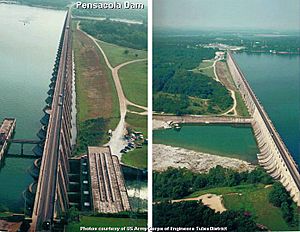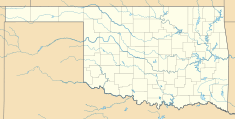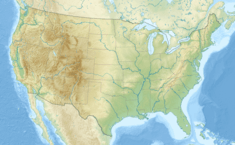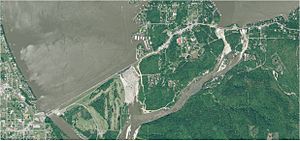Pensacola Dam facts for kids
Quick facts for kids Pensacola Dam |
|
|---|---|

East and west view of dam, courtesy USACE
|
|
|
Location in Oklahoma
|
|
| Country | United States |
| Location | Mayes County, near Disney and Langley, Oklahoma |
| Coordinates | 36°28′19″N 95°01′57″W / 36.47194°N 95.03250°W |
| Status | In use |
| Construction began | February 1938 |
| Opening date | March 21, 1940 |
| Construction cost | $21 million USD |
| Dam and spillways | |
| Impounds | Grand River |
| Height | 150 ft (46 m) |
| Length | Total: 6,565 ft (2,001 m) Multiple-arch section: 4,284 ft (1,306 m) Arches and spillways: 5,145 ft (1,568 m) |
| Spillways | 3 |
| Spillway type | Ogee-type, tainter gate-controlled |
| Spillway capacity | 525,000 cu ft/s (14,900 m3/s) |
| Reservoir | |
| Creates | Grand Lake o' the Cherokees |
| Total capacity | 1,672,000 acre⋅ft (2.062×109 m3) |
| Surface area | 46,500 acres (18,800 ha) |
| Maximum length | 66 mi (106 km) |
| Normal elevation | 742 ft (226 m) (normal) |
| Power station | |
| Operator(s) | Grand River Dam Authority |
| Commission date | 1941 |
| Turbines | 6 x 20 MW Francis-type |
| Installed capacity | 120 MW |
|
Pensacola Dam
|
|
| Architect | John Duncan Forsyth, W. R. Holway |
| NRHP reference No. | 03000883 |
| Added to NRHP | September 9, 2003 |
The Pensacola Dam, also called the Grand River Dam, is a huge dam on the Grand River in Oklahoma. It sits between the towns of Disney and Langley. This dam is run by the Grand River Dam Authority and it creates a large lake called Grand Lake o' the Cherokees.
The dam was built between 1938 and 1940. Its main jobs are to create electricity, control floods, and offer fun activities like boating. It was Oklahoma's very first power plant that used water to make electricity. It's also known as the longest multiple-arch dam in the world!
Contents
How the Pensacola Dam Came to Be
The idea for a dam on the Grand River started way back in the late 1800s. A man named Henry C. Holderman, who was part of the Cherokee Nation, dreamed of bringing electric power to his people. In 1895, he and his friends even did the first survey of the river using their own handmade houseboat.
Holderman had worked on dam projects in India and Africa before returning to Oklahoma. He was so determined that he sold his land and borrowed money to buy rights to the dam sites he had found. For many years, Holderman and a group called the "Rainbow Chasers" tried to get money for the dam, even visiting Washington DC many times.
Early Attempts and Challenges
The dam almost got built in 1914 by British investors, but World War I stopped their plans. In 1920, Holderman turned down an offer from Chicago businessmen. Then, in 1929, the stock market crash ended hopes of Canadian engineers building the dam.
People who supported the dam, including state and federal officials, argued that it would provide hydroelectric power and help Oklahoma's economy. However, local energy companies didn't like the idea of a state-run electric company.
The Great Depression and New Hope
The tough times of the Great Depression actually sped up plans for the dam. In 1928, Oklahoma Representative Everette B. Howard got $5,000 for the U.S. Army Corps of Engineers to study the Grand River. Their study found that building a dam at a spot called "Pensacola" for flood control would cost over $6.2 million. The name "Pensacola" came from an old store on a Cherokee plantation nearby.
At first, the project was mainly for flood control because Oklahoma had limited money and the river didn't have a huge water supply for power.
Getting the Green Light
Oklahoma created the Grand River Dam Authority (GRDA) on January 10, 1935. Finally, on September 18, 1937, with help from Oklahoma Representative Wesley E. Disney, Senator Elmer Thomas, and engineer W. R. Holway, President Franklin D. Roosevelt approved $20 million for the dam. This money came from the New Deal's Public Works Administration. The higher cost was because the dam was now approved for more uses, like making electricity and for recreation. The state government and GRDA also helped raise another $11 million.
Disney pushed hard for the dam, pointing out that Oklahoma's electricity prices were much higher than other states. Senator Thomas also played a big part in getting the dam approved and funded.
Designing the Dam
Once the dam was approved, W. R. Holway, the main engineer, started work in October 1937. The dam was designed as a multiple-arch buttress type. This design was chosen because building materials were expensive during the Great Depression. Also, the ground, made of limestone and chert, was perfect for this type of dam.
John Duncan Forsyth was the architect. He gave the dam and its power plant an Art Deco style, which was popular at the time. Massman Construction Company was chosen to build the main parts of the dam. Thousands of people moved to the area looking for work, and about 3,000 people ended up working on the dam, earning about $16 a week.
Building the Pensacola Dam
Construction started in February 1938. Workers dug out a huge amount of earth and rock. They also built temporary dams, called cofferdams, to keep the water away while they worked.
On December 30, 1938, Massman Construction began pouring concrete. They poured concrete 24 hours a day for 20 months! In total, they used over 510,000 cubic yards of concrete and 23.9 million pounds of steel and iron to make the dam strong.
The main parts of the dam were finished on March 21, 1940. The lake filled up by the end of that summer. The dam's power plant, with its first four generators, started making electricity in 1941. The dam was finished in just 26 months, which was ahead of schedule! This was partly because eastern Oklahoma had its driest 18 months on record during construction, which meant fewer delays from floods.
The U.S. government took control of the dam in November 1941 to help with the World War II effort. They gave it back to the GRDA in 1946.
Impact on Native Americans
Building the Pensacola Dam meant that some land belonging to Native American tribes was flooded. About 1,285 acres of Cherokee land and 802 acres of Quapaw Indian Agency land were lost. Most of this belonged to the Seneca-Cayuga Tribe. Half of their special ceremonial area along the Elk River was also flooded. Even though they lost land, some tribe members had to find work on the dam project.
Power Plant Improvements
In the 1950s, two more generators were added to the power station, making a total of six. Between 1995 and 2003, all six hydroelectric generators were updated. This made the power plant stronger, increasing its ability to make electricity from 92 MW to 120 MW. It also helped it generate 20% more power. Each fall, one generator was taken out, updated, and put back into service by the next spring. The last upgrade was finished in May 2003.
How the Dam is Designed
The Pensacola Dam is a special type of dam called a multiple-arch buttress dam. It has 51 arches and three spillways (places where excess water can flow out). The dam is about 150 feet tall above the river bed.
The total length of the dam is about 6,565 feet. The part with all the arches is 4,284 feet long. Each arch is 60 feet wide, and the support walls (buttresses) are 24 feet wide. These buttresses are very strong, built to hold back a lot of pressure.
The main spillway is 861 feet long and has 21 large tainter gates. These gates are 25 feet tall and 36 feet wide. Two huge hoists operate them. There are also two other spillways about a mile northeast of the dam. They have another 21 tainter gates. All three spillways together can release a massive amount of water if needed.
Oklahoma State Highway 28 crosses right over the top of the dam and a bridge over the main spillway. Cars and trucks can drive across it.
Grand Lake o' the Cherokees
The lake created by the dam is called Grand Lake o' the Cherokees. It can hold a huge amount of water, including space for flood control. The lake covers about 46,500 acres and stretches 66 miles upstream. It has about 1,300 miles of shoreline, which is great for recreation! The normal water level of the lake is about 742 feet above sea level.
The Power Station
The dam's power station is at the bottom of the dam's western end. It's a large building, 279 feet long, 72 feet wide, and 60 feet tall. Inside, there are six 20 MW Francis turbine generators. These generators make 335 million kWh of electricity every year! Each generator gets its water from its own large pipe, called a penstock. The power plant makes the most electricity in the summer and the least in the winter.
How the Dam is Managed
The power station is regulated by the Federal Energy Regulatory Commission (FERC). This agency makes sure the dam follows rules for making electricity. The current license for the dam was given in 1992 and will expire in 2022.
When the lake's water level gets too high (above 745 feet), the U.S. Army Corps of Engineers (USACE) takes over control of releasing water. They manage flood control for the whole river basin. The GRDA and the Corps of Engineers often work together to decide when to release water and how high the lake should be.
Challenges and Solutions
Sometimes, the way water is released from the dam can cause problems. Since the dam has many purposes (flood control, power, recreation, environment), different groups have different needs. For example, if the Corps of Engineers asks for very little water to be released to prevent flooding downstream, it can lower the amount of oxygen in the river. This has caused fish to die, like in July 2007 when at least 5,000 fish died.
Some people, like Oklahoma State Representative Doug Cox, argue that large water releases hurt the state's economy. For example, an off-road park downstream can get flooded. People want a better way to manage water releases. The GRDA is looking into adding devices to put more oxygen into the water and is studying the problem.
In recent years (2019-2020), people living in the town of Miami and nearby Native American groups have worried that if the lake's water levels are raised, it could make Miami's flooding problems worse.
Visiting the Dam
If you want to learn more, the GRDA offers free tours of the dam between Memorial Day and Labor Day. In 2010, over 9,000 people visited, and that number has been growing! Also in 2010, the Ecosystems and Education Center was built. It's now part of the tour. This center is a research lab for water and fish, and it teaches visitors about hydropower and safety around water and electricity.




